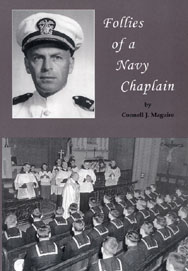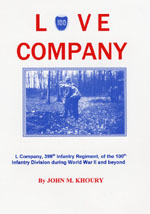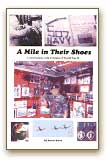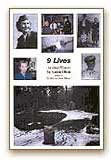©2014 John M. Khoury
Chapter 3
Armored Infantry Basic Training
In Camp Upton at Yaphank, Long Island, in May 1943, I received my army uniform, boots, mess kit, toiletries and other items. The clothing fit me fairly well even though no alterations were made. The accommodations consisted of an eight-man tent with a cot, blanket and pillow for each recruit. The pot-bellied stove in the center of the tent provided ample heat at night. The order of the day was for every member of the cadre to yell as loud as they could because they apparently thought we could not hear their instructions. We had to march in a group everywhere: to the mess hall for chow, to the medics for shots or psychological evaluation and to the main building for oral and written tests.
I took various intelligence and aptitude tests while suffering a mild case of diarrhea because the army food did not agree with my digestive system. The meal consisted of some strange tasting meat that caused distress for many of the recruits. I spent part of the time for the test on the line for the latrine. Needless to say, I didn't do as well on the tests as I would have under normal conditions.
When I was asked which service I would like to join, I chose the tank corps. My feeling of patriotism was very high and I wanted to be in the middle of the action. Within days, I was in Fort Knox, Kentucky, at the Armored Replacement Training Center (ARTC) where I had my basic training. The first thing I learned was that this was an elite corps where you were different from the rest of the Army. You wore your overseas cap on the left side of your head, not on the right side like all the other units in the Army. You were expected to be cocky and proud of being in the armored force.
Our platoon leader was Lt. Davis. He was blond, of medium height, young, slender and from the South. He was the most obnoxious person I had ever met. He cursed us. He ran us from reveille to taps. He nagged and was never satisfied with anything we did. He told us, "I want you to hate me! I don't want to be your buddy! I don=t want you to like me! I am your commanding officer and you do what I tell you! I am going to make soldiers of you! You are going to kill or be killed! You are not expected to die for your country! You are expected to make the enemy die for his! That's why you are here!" The message was loud and clear: He loved us!
The training was absolutely the most thorough. Although I never got into a tank, I learned to drive almost every vehicle from a jeep to a half-track. The half-track was a lumbering, armor-plated, open-topped truck with wheels in the front and tracks in the rear that could go about 45 miles an hour on an open road and carry a squad of infantrymen. I was also trained on almost every weapon in the Army, including the 45 caliber revolver and pistol, Thompson submachine gun, greasegun, M1 carbine, 1917 Enfield rifle, Garand M1 rifle, all of which I could take apart, clean, and reassemble. I was also briefly instructed on the 30 caliber light machine gun, .50 caliber machine gun, 37mm cannon, 57mm cannon, bazooka, hand grenade, rifle grenade, bayonet, and mortar and learned to use each of them.
I had the dubious pleasure of crawling on my stomach, with other trainees, on a muddy field with my rifle cradled in my arms, wearing a helmet and field pack, under barbed wire while machine guns fired over our heads and explosives were set off around us. The feeling of being in actual combat seemed almost real except that we knew it was a training exercise.
We were also taught about explosives -- the use of dynamite, detonators, and fuses even though that was a specialty for the combat engineers. We never had the chance to actually set off a charge which would have been a blast. Probably, we would have lost too many men because you were allowed only one mistake in that trade.
There was gas mask drill held in an airtight room with exposure to various poison gases: mustard, lewisite, and phosgene. We had to learn to recognize each of them at the first whiff and don our gas masks plus protective covering in the case of mustard gas.
The training cadre also taught us how to use our bare hands to deliver chopping blows to the neck, throat, nose, and abdomen that would maim, disable, or even kill an enemy. Whether this would actually work in hand-to-hand combat, we had to take on faith. No live demonstrations were offered, but the message was that we were in a deadly business.
We had weekly 5 to 15 mile hikes with full field packs and a final hike of 25 miles which took about 8 hours. This ultimate hike was made in the full blaze of summer heat with full field equipment, including rifle and helmet. An Army ambulance trailed the company to help any soldier who dropped out because of heat exhaustion or cramps. Most of us made it and we returned to the barracks completely exhausted. I and some others were so tired that we found it was impossible to lie down and sleep. We took a shower instead and went to the canteen or the recreation room and sat in a daze until chow time.
In addition to all that, there was the obstacle course of scaling a wall, swinging on a rope over a ditch, and running at full speed. We practiced reconnaissance patrols, did guard duty, studied map reading, worked in the kitchen, exercised the manual of arms, and marched in drill routines.
The final exercise was a week of maneuvers with the "Blue Army" against the "Red Army" in the field with patrols, attacks, flanking movements, and such. I don't remember which side won, and I never understood what we were doing. I was the driver of a half-track which had heavy armor plate on the sides and the rear. In front, there was no windshield but it had a one inch thick armor-plate shield of steel that was hinged to lift or lower as needed for protection. When it was lowered in place, a four inch square opening in the steel allowed the driver to see ahead. I drove it wherever I was ordered. On the roads, this clanking vehicle was fairly easy to drive, but when it had to go into the woods and open fields, it was slow and cumbersome. It was even more difficult at night, with blackout headlights. I had to avoid hitting trees and driving into a gully. I did hit a tree stump and it crunched the running board on the left side. At that point, I wanted to give up the wheel and sit in the back of the truck. However, the lieutenant kept me as his driver. When we stopped to bivouac, I had to check the half-track from top to bottom. That meant checking the engine oil, tires, tracks, gasoline gauge, etc. That was my responsibility as the driver.
Then I could eat, pitch a pup tent, or dig a foxhole and rest. I was told that this was like the cavalry where the rider had to feed and tend his horse before himself.
Basic training ended with a "king of the hill" battle where one platoon stood on top of a small mound and had to defend it against an "enemy" platoon attacking from below with both sides wearing boxing gloves. After a half hour of going up the hill and being knocked back down, a break was called and positions were reversed. There was more laughing than broken noses.
By September 1943, I had completed 13 weeks of basic training and received my Pfc. stripe, a Good Conduct medal and a Marksman medal for firing the rifle. After a two-week furlough, I returned to Fort Knox and was placed in a group that was shipped out to the 14th Armored Division at Camp Chaffee near the small town of Fort Smith, Arkansas.
I soon found myself sitting in the back of a halftrack and assigned to an armored infantry company. This did not appeal to me very much, because a nice guy like me could get killed in this outfit. I thought that a more suitable service would be the Army Air Corps, where the glamour of flying into the "wild blue yonder" had greater appeal.
Since the Air Corps needed airmen and they had reduced the requirement from 20/20 vision to 20/30 vision, I applied for a transfer and was given a physical examination. Despite hereditary second degree flat feet, a broken nose from football, a scarred right eardrum from an infantile abscess that was lanced and healed, I was passed on each count.
The critical moment came when I had to take the eye test. I had 20/40 vision and hoped I could read the 20/30 line. A buddy of mine, with the nickname of "Twist" -- probably because his name was really Oliver -- was in line ahead of me. He could see the eye chart through the small opening in the door and read the 20/30 line to me, which I memorized.
When I went in for the test, I read the 20/30 line with the left eye closed and then the right eye closed, and I could have done it with both eyes closed. I passed and was transferred to the Army Air Corps. They issued me my first pair of glasses to correct my eyesight to 20/20. In the meantime, Twist passed every test but was washed out because he was color-blind! I suppose he stayed with the 14th Armored Division.
(If you would like to order an autographed copy of "Love Company," please contact the author, John M. Khoury)






